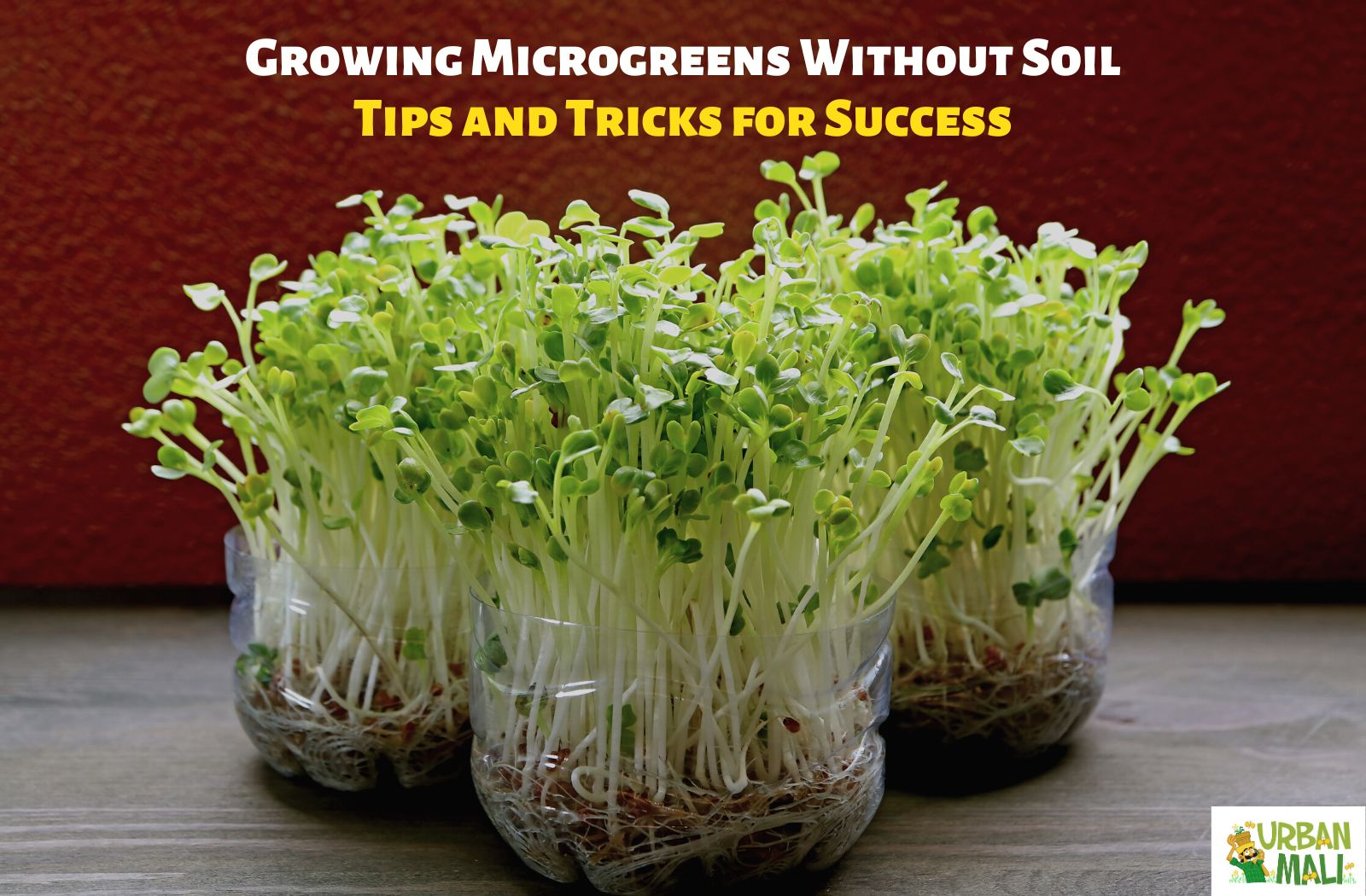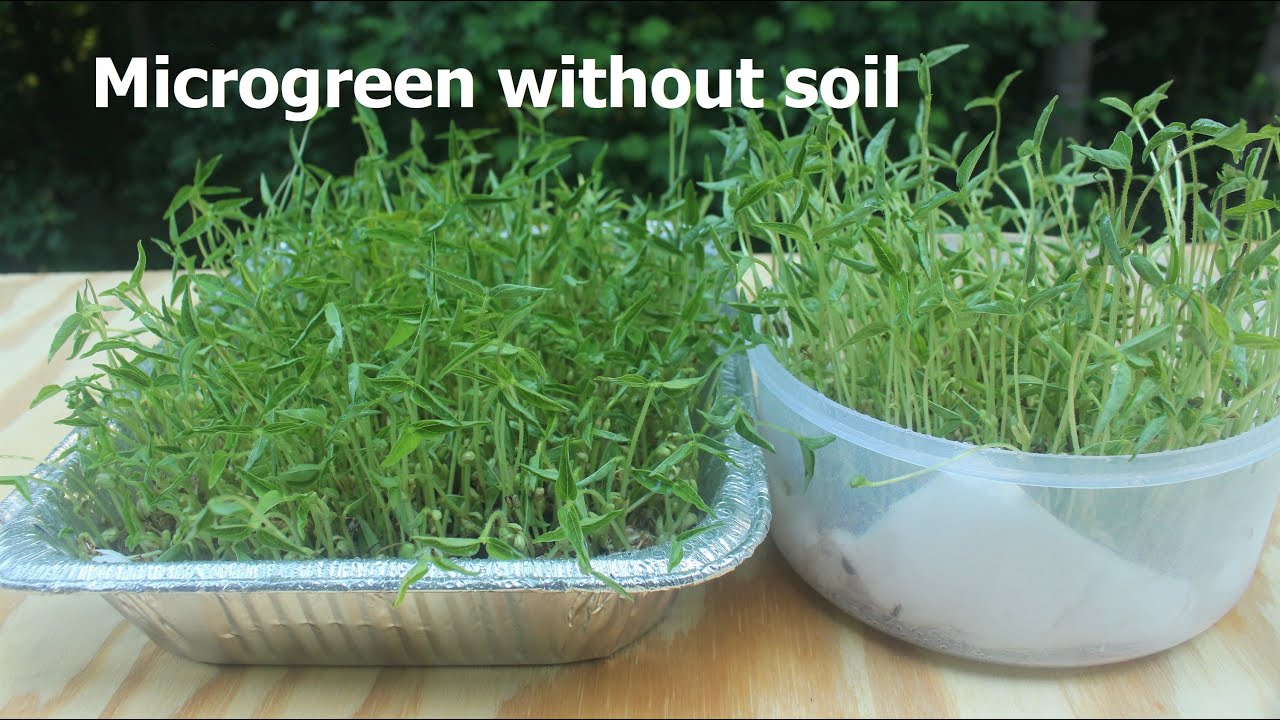To grow microgreens without soil, use hydroponic systems that provide necessary nutrients directly to the roots. Microgreens can be grown in water-based mediums with added nutrients for optimal growth.

Credit: www.urbanmali.com
Microgreens have gained popularity as a nutrient-rich addition to salads, sandwiches, and other dishes. These tiny greens are packed with flavor, vitamins, and minerals, making them a popular choice among health-conscious individuals. While traditional gardening methods involve soil, it is possible to grow microgreens without it.
Hydroponic systems offer an efficient and soil-free solution for cultivating these delicate greens. By using a water-based medium enriched with essential nutrients, you can provide the ideal environment for microgreens to thrive. We will explore the benefits of growing microgreens without soil and discuss the steps to successfully grow them using hydroponics.
Getting Started With Microgreens Without Soil
Microgreens have become increasingly popular for their nutritional value and intense flavors. Growing them without soil is a convenient option for many. To get started, it’s important to choose the right microgreens for soilless growing. The benefits of this method are numerous.
Firstly, it eliminates the need for soil, making it a cleaner and easier process. Secondly, it saves space as soilless microgreens can be grown in small containers or trays. Additionally, growing microgreens without soil reduces the risk of pests and diseases typically associated with traditional gardening.
Moreover, this method allows for faster growth and quicker harvesting of microgreens. With proper care and attention to hydration and nutrition, you can successfully grow vibrant and nutritious microgreens without the use of soil. So go ahead and give it a try!
How to Grow Microgreens Without Soil : Step by Step Guide
Step 1: Selecting The Right Growing Medium
Growing microgreens without soil is possible by selecting the right growing medium. Hydroponics and aquaponics systems are popular alternatives that require understanding. These systems allow plants to thrive without traditional soil. Exploring other mediums, such as coconut coir or perlite, can also yield successful results.
These alternatives provide adequate support and nutrition for microgreens. It’s important to consider factors like water retention and nutrient availability when choosing a growing medium. By selecting the appropriate medium and utilizing hydroponics or aquaponics systems, microgreens can flourish without soil.
With these innovative approaches, anyone can enjoy the benefits of growing microgreens in their own home, regardless of lacking traditional soil.
Step 2: Setting Up A Soilless Microgreens Growing System
To grow microgreens without soil, setting up a soilless growing system is crucial. Designing your setup requires careful consideration. First, ensure proper lighting to provide adequate energy for the plants. Secondly, maintain proper temperature control to create an optimal environment.
Remember to avoid using commonly overused words and phrases and keep sentences brief. Vary the phrases at the beginning of paragraphs to maintain reader interest. By implementing these guidelines, you can successfully grow microgreens without soil.
Step 3: Preparing The Seeds For Germination
To ensure proper germination, it is essential to select high-quality microgreen seeds. Start by soaking the seeds in water for a few hours. This will help soften the outer layer and promote faster germination. After soaking, rinse the seeds thoroughly to remove any remaining debris.
This step is important to maintain optimal moisture levels for germination. Rinsing also prevents the growth of mold or bacteria. Ensure that the seeds are evenly distributed before placing them in your chosen growing medium. By following these steps, you can maximize the success of your microgreen growing project and enjoy a bountiful harvest.
Step 4: Germination And Growth Process
Germination and growth process is an essential step when it comes to growing microgreens without soil. Sowing the seeds in the proper growing medium is crucial for success. It is important to provide the seeds with proper care and maintenance in order to ensure healthy growth.
Regular watering and adequate sunlight are necessary for the germination and growth of microgreens. Additionally, maintaining the right temperature and humidity levels are also crucial for their development. It’s important to monitor the soil moisture and avoid overwatering. Proper ventilation is also important to prevent the growth of mold and fungal diseases.
With proper care and attention, you can successfully grow microgreens without soil and enjoy the benefits of fresh and nutritious greens in your home.
Step 5: Harvesting And Storage
Harvesting microgreens at the right time is crucial to ensure their optimal flavor and nutrition. Look for the first true leaves to appear, usually after one to two weeks of growth. These leaves should be fully developed but still tender.
To harvest, use a pair of clean, sharp scissors to cut the stems just above the soil surface. Avoid cutting too close to the roots. After harvesting, gently rinse the microgreens with cool water and pat them dry with a clean towel.
To store them, lay them in a single layer on a paper towel and roll it up, then place the bundle in a perforated plastic bag in the refrigerator. Microgreens can be stored this way for up to a week, although it’s always best to consume them as soon as possible for maximum freshness and flavor.
Troubleshooting Common Soilless Microgreens Challenges
When growing microgreens without soil, it is common to encounter challenges related to nutrient deficiencies and pest and disease prevention. Nutrient deficiencies can be identified by observing yellowing leaves or stunted growth. To address this issue, it is important to ensure the microgreens are receiving adequate nutrition through appropriate fertilization and nutrient solutions.
In soilless systems, pests and diseases can still occur, such as aphids or fungal infections. Regular monitoring and prevention strategies, such as practicing good hygiene and using organic pest control methods, can help mitigate these problems. It is crucial to maintain a clean growing environment and provide optimal growing conditions to promote healthy growth and yield.
By addressing these common challenges, growers can successfully cultivate vibrant and nutritious microgreens without soil.
Expanding Your Soilless Microgreens Garden
Expanding your soilless microgreens garden can be an exciting venture. Experimenting with different varieties adds interest. You can prolong the growing season by scaling up your soilless operation. With careful planning and attention to detail, you can successfully grow microgreens without soil.
These greens offer nutritional benefits and vibrant flavors. By using alternative growing mediums like coco coir or hydroponic systems, you can create a sustainable and efficient garden. Maintaining proper lighting and temperature conditions is crucial for growth. Regular monitoring and watering are also essential.
So start expanding your soilless microgreens garden today and enjoy the fresh, healthy greens you can grow right at home
Frequently Asked Questions Of How To Grow Microgreens Without Soil
What Can I Use Instead Of Soil For Microgreens?
You can use alternatives to soil like coco coir, peat moss, vermiculite, or hydroponics for growing microgreens.
Can You Sprout Microgreens Without Soil?
Yes, microgreens can be sprouted without soil.
How Do You Grow Microgreens In A Jar Without Soil?
To grow microgreens in a jar without soil, follow these steps: 1. Soak seeds in water overnight. 2. Place a paper towel in the jar and spread seeds on top. 3. Rinse seeds daily and keep the jar in a well-lit area.
4. Harvest when the microgreens reach desired height.
Can I Grow Microgreens In Just Water?
No, microgreens cannot be grown in just water. They need a growing medium for proper growth.
Conclusion
Growing microgreens without soil is an innovative and sustainable way to cultivate nutritious greens right in your own home. By utilizing hydroponic or soil-less growing techniques, you can nurture these tiny plants to thrive and provide a constant supply of fresh greens.
With the right equipment, such as trays, lights, and a water-based nutrient solution, you can enjoy the benefits of this soil-free gardening method. Not only does growing microgreens without soil save space, time, and resources, but it also offers the opportunity to experiment with a wide variety of flavors and textures.
Whether you’re a seasoned gardener or a beginner, this soil-less approach provides an accessible way to grow your own nutritious greens throughout the year. So why wait? Start your soil-less microgreen growing journey today and enjoy the endless possibilities and health benefits that these small but mighty plants have to offer.

